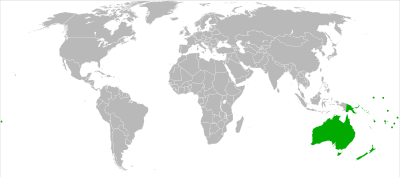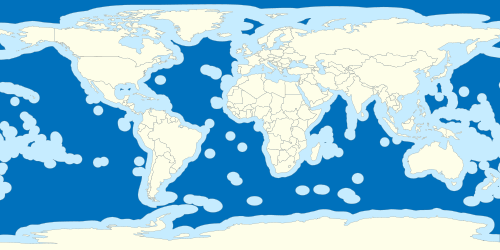Treaty of Rarotonga
The Treaty of Rarotonga is the common name for the South Pacific Nuclear Free Zone Treaty, which formalises a Nuclear-Weapon-Free Zone in the South Pacific. The treaty bans the use, testing, and possession of nuclear weapons within the borders of the zone.[1][2]


It was signed by the South Pacific nations of Australia, the Cook Islands, Fiji, Kiribati, Nauru, New Zealand, Niue, Papua New Guinea, the Solomon Islands, Tonga, Tuvalu, Vanuatu and Western Samoa on the island of Rarotonga (where the capital of the Cook Islands is located) on 6 August 1985, came into force on 11 December 1986 with the 8th ratification, and has since been ratified by all of those states.
The Federated States of Micronesia, Marshall Islands, and Palau are not party to the treaties but are eligible to become parties should they decide to join the treaty in the future.
Protocols binding other states
There are three protocols to the treaty, which have been signed by the five declared nuclear states, with the exception of Protocol 1 for China and Russia who have no territory in the Zone.
- no manufacture, stationing or testing in their territories within the Zone
- no use against the Parties to the Treaty, or against territories where Protocol 1 is in force
- no testing within the Zone
In 1996 France and the United Kingdom signed and ratified the three protocols. The United States signed them the same year but has not ratified them. China signed and ratified protocols 2 and 3 in 1987. Russia has also ratified protocols 2 and 3 with reservations.[3]
Scope of applicability

The treaty's different provisions apply variously to the Zone, to the territories within the Zone, or globally.
"South Pacific Nuclear Free Zone" means the area :
- south of the Equator
- north of the 60th parallel south (the northern limit of the Antarctic Treaty zone)
- east of the 115th meridian east
- west of the 115th meridian west (the western limit of the Treaty of Tlatelolco Latin American Nuclear-Weapon-Free Zone)
plus three projections north of the Equator to include the territory and territorial waters of Papua New Guinea, Nauru, and Kiribati, but minus the northwest corner beyond Australian territorial waters and near Indonesia (and the Southeast Asian Nuclear-Weapon-Free Zone).
Several islands in the Indian Ocean also belong to Australia and are therefore part of the zone.
"Territory" means internal waters, territorial sea and archipelagic waters, the seabed and subsoil beneath, the land territory and the airspace above them. It does not include international waters. Article 2 says "Nothing in this Treaty shall prejudice or in any way affect the rights, or the exercise of the rights, of any State under international law with regard to freedom of the seas."
The Treaty is an agreement between nation-states and as such of course cannot apply to those who have not signed the treaty or protocols, for example, the four countries not signatories to the Non-Proliferation Treaty, who are all nuclear powers.
List of states and territories
- The only territory north of the Equator that is part of the Zone is in Kiribati, the only state straddling the Equator.
- Micronesia is outside the Zone except for Kiribati.
- Melanesia is inside the Zone except for Indonesia, which is in the Southeast Asian Nuclear-Weapon-Free Zone.
- Polynesia is inside the Zone except for Easter Island, which is in the Latin American Nuclear-Weapon-Free Zone, the Polynesian outliers of Kapingamarangi and Nukuoro in Micronesia, Hawaii, American Samoa and several uninhabited US Minor Outlying Islands.[4]
| State | Signed | Deposited |
| Sep 6, 1985 | Dec 11, 1986 | |
| Sep 6, 1985 | Oct 28, 1985 | |
| Sep 6, 1985 | Oct 4, 1985 | |
| Sep 6, 1985 | Oct 28, 1985 | |
| Jul 17, 1986 | May 13, 1987 | |
| Sep 6, 1985 | Nov 13, 1986 | |
| Sep 6, 1985 | May 12, 1986 | |
| Sep 16, 1985 | Sep 15, 1989 | |
| Sep 6, 1985 | Oct 20, 1986 | |
| May 29, 1987 | Jan 27, 1989 | |
| Jul 2, 1996 | Dec 18, 2000 | |
| Sep 6, 1985 | Jan 16, 1986 | |
| Sep 16, 1995 | Feb 9, 1996 |
References
- "South Pacific Nuclear-Free Zone Treaty (Treaty of Rarotonga)" (PDF). Retrieved 26 December 2012.
- "South Pacific Nuclear-Free Zone (SPNFZ) Treaty of Rarotonga | Treaties & Regimes | NTI". www.nti.org. Nuclear Threat Initiative | NTI. Retrieved 5 November 2016.
- "Ratifications" (PDF).
- "Disarmament Treaties Database: Treaty of Rarotonga". disarmament.un.org. UNODA – United Nations Office of Disarmament Affairs.